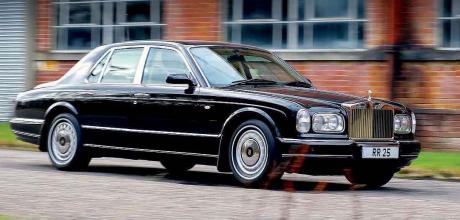1998 Rolls-Royce Silver Seraph
The team that created the Silver Seraph couldn’t have known it would be the last Rolls-Royce built at Crewe, nor that it would have such a short life. How has yesterday’s dead end become today’s sought-after classic?
WORDS: NIGEL BOOTHMAN
PHOTOS: LEWIS HOUGHTON
‘Oh, a Seraph? You’ll enjoy that. They drive better than Arnages.’ The voice on the other end of the phone is a friend of mine, a Rolls-Royce and Bentley specialist. Naturally I’d told him what I’d been looking forward to – a photoshoot with an immaculate, 26,000-mile Rolls-Royce Silver Seraph. It would be the first time I’d driven one. Nonetheless, I was a bit taken aback by that assertion of his. After all, a good Arnage is a wonderful thing, either in sophisticated 4.4-litre, 32-valve form, or with the immense low-down grunt from the L-series 6.75-litre V8. How would a Silver Seraph be any better? ‘It’s hard to describe,’ he says, ‘but it’s something to do with balance. You’ll find out.’
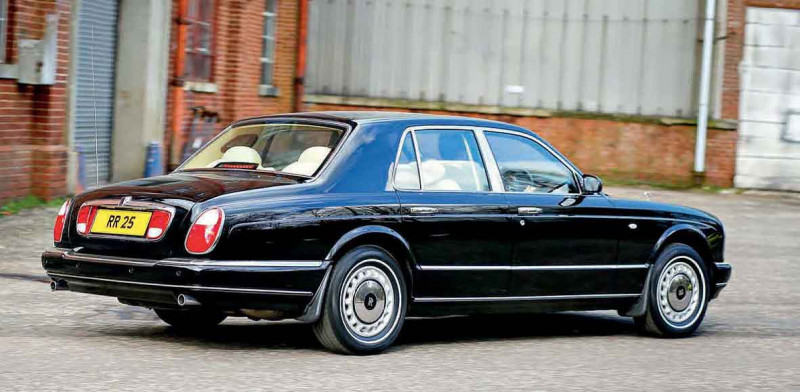
“Yes, the powerplant is rather different and there are German-made dash controls, but it’s unmistakably a Rolls-Royce.”
I arrived the next day to collect the car from Derek Mowat, a man who often has interesting cars on his hands, as he specialises in finding and supplying classic Rolls-Royce and Bentley models, as well as other high-end marques. As soon as I mentioned the phone call, he was agreeing – yes, they’re really underrated. Cherish it, and it’s a wonderful car. There are good reasons why they’re leaving the values of equivalent Arnages a long way behind. By now I was thoroughly intrigued, so I took the keys, thanked Derek and slid into the driver’s seat. Straight away, it’s a bit more subdued than an Arnage. Of course, individual cars vary a good deal, but one thing that sets the Silver Seraph apart from most Arnages is the dials, which are as dark as the leather on the steering wheel and dash top. It’s easier on the eye, to me anyway, than the pale instruments in the earlier Arnages. The wood has a darker, more mellow tone, presumably chosen to blend well with the dials and dash leather. The fine walnut ‘pinstripe’ that runs around the fillets of veneer adds a certain something. It all contrasts pleasingly with the light, soft hides on the seats and door cards, which keep the interior from becoming gloomy – as does this colossal sunroof. And is that really a pop-up satellite navigation screen, in a car from the year 2000? It may be less accurate than your smartphone these days, but it’s mighty impressive.
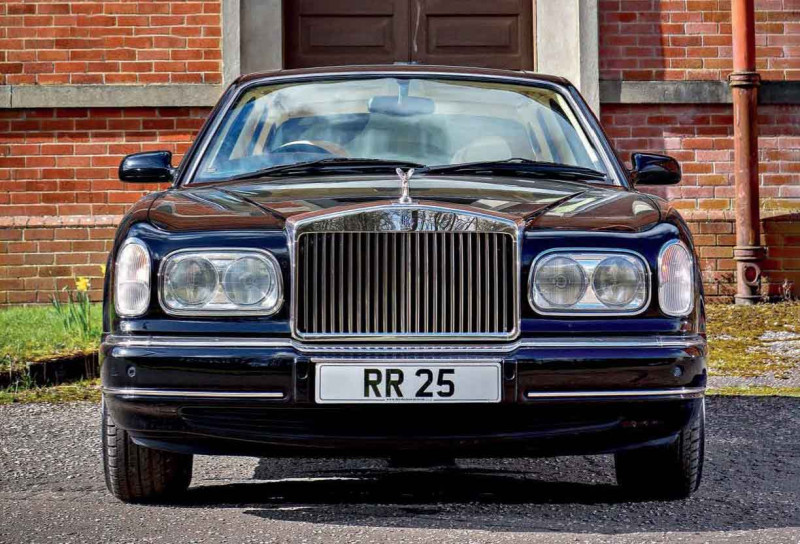
The sunroof does rob a bit of headroom, and I cannot get the seat low enough to keep my head from touching the ceiling. I’m tall enough to encounter this problem in various cars, so it’s not a major failing for the Seraph. However, I can’t move the wheel closer towards me, which does seem like a missed opportunity for ideal ergonomics. The seats feel a little short too, so I’m resting on the upper shape of the bolster rather than the main seat back. The squab is pleasant though, and it has that old Rolls-Royce quality of becoming more comfortable the longer you sit in it. So much for sitting still, what’s it like on the move?
QUIET AS A…GHOST?
Frankly, it’s a spooky car to drive. It is so subdued and quiet, I can hear my watch ticking, which is quite annoying. Maybe that’s why you need a stereo, though the Pioneer head unit is best left concealed by the flip-down veneered door. I managed to change its script to Chinese before I could find a radio station. The BMW 5.4-litre V12 engine is remote, offering a distant thrum that varies in pitch rather than volume as you depress the accelerator. Push it harder, and you can just about hear it making a pleasant, mellifluous effort. The 0-60mph time is apparently 6.9 seconds, and it’s never been accomplished in such a serene manner. The Silver Seraph gathers pace unstoppably, without ever doing anything as vulgar as noisy acceleration. Indeed, if the performanceseems at all blunted, it’s down to the gearbox rather than the engine. It’s reluctant to kick down and let the engine rev high unless you’re very firm with the pedal, but it seems more accelerative the faster you’re going. It’s a serene motorway car – hundreds of miles must vanish quite painlessly. Suddenly we meet a huge pothole, the kind I would swerve to avoid if there wasn’t a bus coming the other way…
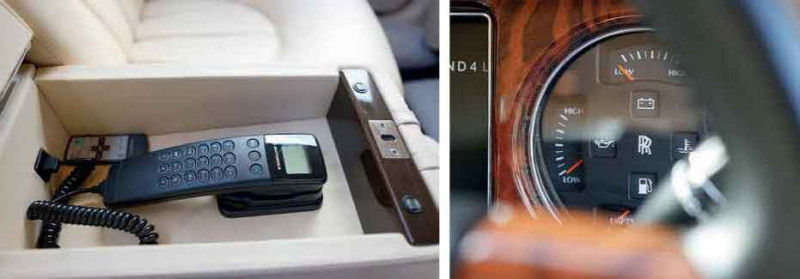
but the Seraph isn’t really bothered. A slight tremor through the chassis, a twitch of the wheel, but it’s remarkably well insulated from the big bumps. Small undulations can send faint wobbles through the car, which seems to be unavoidable with such soft springing and gentle (though adaptive) damping. The price of a cosseting ride, perhaps. The steering is beautifully weighted; not the one-finger American experience at all; far more in touch with the road. It’s well matched with the suspension, which gives an altogether more polished performance than the old SZ platform when the curves appear. Here, we have double-wishbone arrangements at each corner, teamed with a bodyshell 65% stiffer than its predecessor, andyou notice as soon as you push into a bend. The body roll of previous Rolls-Royce generations is much reduced. Opening the sunroof creates a nice airy impression, though at speed it produces a little more wind noise than you’d hope, something you notice on the motorway even when it’s shut – probably because the rest of the car is so silent. It has acquired the effective, dominant, large-car feel without being noticeably high. In an SZ saloon and indeed in a Goodwoodera Phantom you feel taller than other saloon cars, so it would be interesting to get all three side-by-side and compare seat height. These impressions can often be illusory, after all.
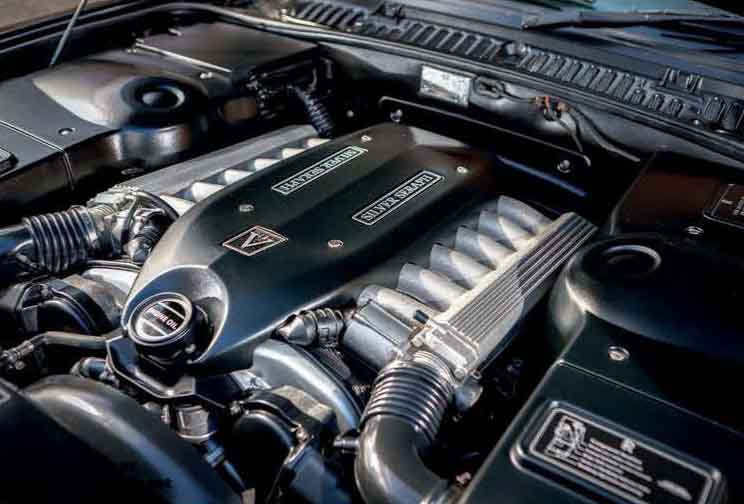
The brakes are interesting. They have something clever going on; you can feel good initial retardation with light pedal pressure but then you need to push a good deal harder to initiate a full-on emergency stop. This avoids the accidental head-butt of the steering wheel that can happen with pump-powered hydraulic systems; ask anyone who’s driven an old Citroën. It’s something Rolls-Royce anticipated all the way back with the first SY generation cars in 1965 by adding a conventional master cylinder circuit, and it’s more refined still in the Silver Seraph. There is a familiar feel to the whole car, despite the all-new platform, driveline and body structure. A blindfolded passenger, led deftly into the car and taken for a ride, would be guessing correctly even without the perfume of expensive leather seats. Crewe’s careful fingerprints are all over it, and as such it provides a clear link from the SZ generation to the 21st century cars. Yes, the powerplant is rather different and there are German-made dash controls, but it’s unmistakably a Rolls-Royce.
ROCKY RECEPTION
The Germanic influence was, of course, the stick used by Rolls-Royce’s detractors to beat the Silver Seraph after its launch at the Geneva Motor Show in 1998. This took two forms; the conceptual (a British icon should never stoop to using German parts) and the practical (these switches and stalks are too familiar and lack class, or this V12 engine needs to be revved too hard to deliver its performance). Neither view stands up to much scrutiny. Crewe had been using American automatic transmissions and braking adapted from a French system for decades, and for that matter no-one scorned the result when European coachbuilders bodied Rolls-Royce or Bentley chassis. Or indeed when entire cars were made in Springfield, Massachusetts, between 1921 and 1931.
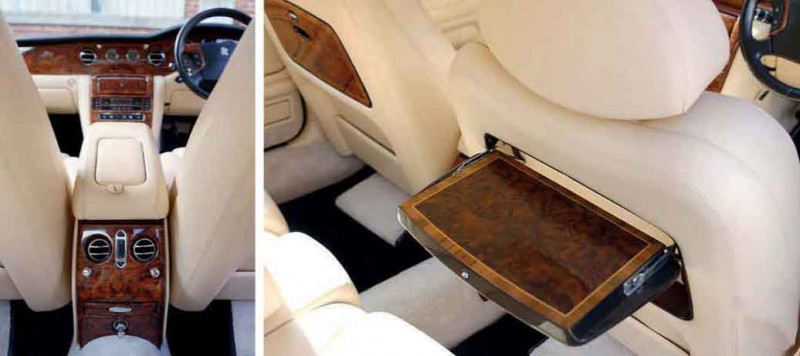
Yes, the engine is the heart of the car,but after a decade that began with a deep recession, a bit of realism was important. If Rover and Lotus could get by with Honda and Isuzu engines, and Aston Martin could save itself with a model based on a Jaguar, perhaps we could cut Rolls-Royce a bit of slack. The practical complaints are a little harder to fight off, but here’s one take: the engine is a superb choice. It works beautifully with the rest of the car and is actually a better option than the 6.75-litre V8 torque-monster, because it’s easier to drive gently. It is, without doubt, smoother andquieter too. Isn’t that what Rolls- Royce have always aimed for? If you want to smoke the tyres and overtake trains of slow traffic, buy a Bentley. There are one or two downsides to the parts-sharing arrangements, but how much they will concern owners is a very personal thing. I’m not bothered by the dash controls because I’ve never owned a BMW of the generation from which the buttons were borrowed, so they don’t seem familiar. Had Crewe gone to Mercedes or Volvo for their controls, I might feel differently. The gear selector is alsoBMW, of course, with a mechanical connection to the transmission, so it’s actually heavier to move with fingertips than the selector on a Silver Shadow or Silver Spirit. But once you’ve put it in D, how much do you care?
There was another area that seemed a legitimate cause for complaint, to the extent that the new German owners made expensive alterations to the bodyshell to correct it. Some journalists invited on a press launch in Scotland compared the room in the back seat of the Silver Seraph rather unfavourably with that in the Ford Scorpio taxis thatRolls-Royce had laid on to bring them to the venue. They weren’t the only ones to notice that the chauffeur was better off than his employer. So this car, a year 2000 model, has a lower rear floor and other adjustments which make it, and its Arnage contemporaries, roomier than the cars built in the first two years. The clear lamp lenses and parking sensors are other subtle signs of this facelift.
FATE TAKES A HAND
The great tumult of Volkswagen’s lastminute purchase of Bentley, and BMW’s subsequent swoop for Rolls-Royce in the summer of 1998 was bound to have casualties, and the Silver Seraph was the most noticeable. In hindsight, it’s a relief that VW and BMW could come to a sufficiently amicable arrangement for Seraph and Arnage production to continue at Crewe for almost four yearsthough promotion and development of the Silver Seraph was essentially frozen. The only new variant was an extended wheelbase model in 2000, separate from the improved rear legroom common to all those on a standard wheelbase, around the same time. In the end, just 1570 Silver Seraphs were built before production ceased in 2002 and Rolls-Royce was effectively handed over to BMW, then completing their new plant in Goodwood.
Thus, the word ‘rare’ is often applied to the Silver Seraph now, but these things are relative – many classic Rolls- Royces are rarer, especially anything coachbuilt, though scarcity is part of the reason why a Silver Seraph is now worth at least twice as much as a 4.4- litre Arnage in equivalent condition. The car we’ve featured here has found a new home at just short of £50,000, while Derek was recently advertising a 2001 model with even tinier mileage at £60,000 – and that too has sold. Yet an Arnage Green Label feels somewhat quicker, probably costs less to run and is a little sportier in corners. Why the price difference? Partly, it’s the name. Rolls-Royce versions of body-sharing models are usually a little more highly valued, at least for models from the 1940s, ‘50s and ‘60s. Partly it’s the exquisite interior. You could also add in the cachet of being the last Crewe-built Rolls-Royce. Then there is that quality you discover when you drive one – that feeling my friend was trying to explain on the phone. He called it ‘balance’, which I now realise wasn’t just a comment on the handling. It’s that everything in the car is in balance with everything else: the ride and body control work well with the steering weight, which works nicely with the brakes, which suit the character of the car, as do the engine and gearbox. The inputs you need for the controls are perfectly balanced, so you don’t upset the car or your passengers by mistake, even if you’re unfamiliar with it. It’s remarkably easy to drive smoothly, and to drive quite fast. It shrinks around you, like the best large cars, and justflows down the road. There’s the right word: flow. It does that better than any Arnage, and it’s rather wonderful.
This example was supplied new through HR Owen and passed through the hands of P&A Wood before finding its second owner in 2011. That gentleman parted with the car last year, aged 94. It’s had the lightest use – barely 1000 miles a year – and is in amazing condition, particularly the seats, which look and smell new. There are vanity mirrors in the back and a set of controls back there for the climate, plus beautifully figured picnic tables. It’s a gorgeous car and a day spent with it has helped me understand why those who worked at Crewe regret the way the Silver Seraph was extinguished so early on, as it does a superb job of replacing the SZ predecessors. It could have lasted a good while longer, had the two companies remained together. It’s interesting to imagine the models that would have grown from it, and indeed the ways in which the Silver Seraph would have been modified before its own replacement, perhaps ten years ago. But fate had other ideas, and in killing the Seraph in its youth, it’s created a sought-after modern classic in the Rolls-Royce market. If you’ve never tried one, now’s the time.
THANK YOU: We’re grateful to Derek C Mowat, who loves a low-mileage Silver Seraph. Check stock at derekcmowat.co.uk or call 07836 740333.
SERAPH STYLING – RETRO, BUT RESTRAINED?
Designing a new Rolls-Royce must be a nerve-shredding business. The basic shape of the Bentley Mk VI / Silver Dawn / R-type standard steel saloon lasted almost 10 years and the Silver Cloud’s form lasted another 10 years. The Silver Shadow managed 15 years and the Silver Spirit almost 20. The Silver Seraph, then, would have had to last beyond 2010. Traditionally, Rolls-Royce stylists had managed this by dodging the most fashionable modernity, so the shape was less likely to look dated after a few years. This is a hugely difficult judgement, and the near decade-long development time of Rolls-Royce models made it harder still, especially looking toward the 21st century.
Nonetheless, chief designer Graham Hull and his team made a success of the Silver Seraph’s styling, in part by looking back rather than forwards. The late 1990s were a time when retro styling was gaining traction as a way to inject a bit of character into car design, especially in Britain – we’ve always been more wrapped up in our own heritage than most other nations. For Rolls-Royce, it was a way to connect with the buyers and offer them a feeling of security. Yes, there were a lot of changes under the skin, but look at the reassuring styling cues! Hull spoke about the design process in detail at the time of the launch and was quoted in Richard Vaughan’s Complete Guide to Rolls-Royce Silver Seraph and Bentley Arnage. Early in his career, he had worked with John Polwhele Blatchley, the man behind the company’s most successful post-war designs. Blatchely had pondered the connection between yacht design and automotive form, and Hull saw it in the shape of the Silver Cloud, even producing a remarkable artwork to show how the side profile of a motor launch could become a coachbuilt form with wheels, then the Silver Cloud, then an evolved, modernised shape with less pronounced wings and finally the Silver Seraph itself. But just resembling an older car was no good – Hull had to mingle some of the traditional looks with a new, more all-encompassing form. Unlike the old coachbuilt shapes, he explained, ‘The new Seraph has no corners. Lamps are actually at angles, there is no squareness there. The separate corner lamps are extremely important in the overall perspective of the car; your eyes go around such elements and move on to the next station, so to speak. Brightwork also takes your eyes around.’
Do you agree? The way the Arnage lasted in the Silver Seraph’s absence suggests the shape pulled off the trick of seeming timeless rather well.
“Scarcity is part of the reason why a Silver Seraph is now worth at least twice as much as a 4.4-litre Arnage in equivalent condition.”
Little different to Arnage at rear, but a well-resolved tail Traditional Rolls-Royce craftsmanship abounds. 5.4-litre V12 is as smooth as engines get. Low, wide Palladian grille allowed more modern frontal aspect. Dark dials look superb; analogue cellphone is a retro remnant.
TECH SPECIFICATION 1998 Rolls-Royce Silver Seraph
- ENGINE: 5379cc V12 BMW M73TUB54
- MAX POWER: 322bhp @ 5000rpm
- MAX TORQUE: 361lb.ft. @ 3900rpm
- TRANSMISSION: ZF 5HP 5-sp auto
- TOP SPEED: 140mph
- ACCELERATION 0-60MPH: 6.9 secs
- SUSPENSION: Double-wishbone independent with adaptive damping
- BRAKES: Ventilated discs all round
- WEIGHT: 2400kg (5291lb)


